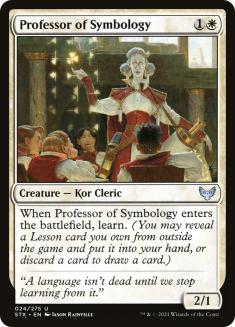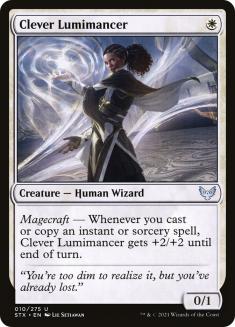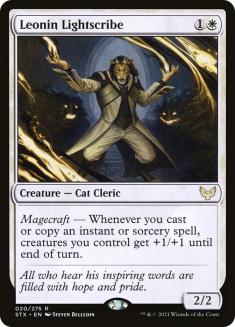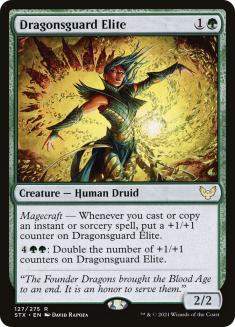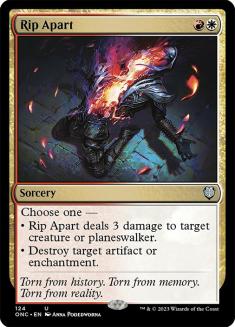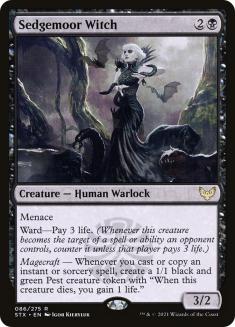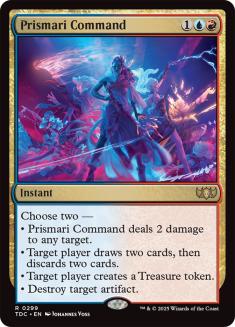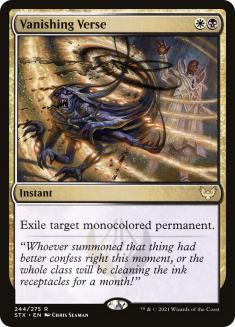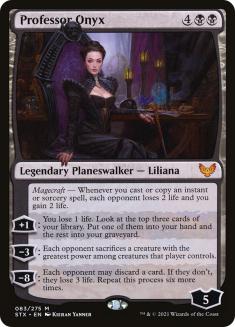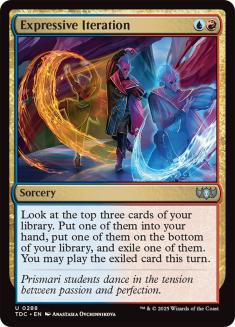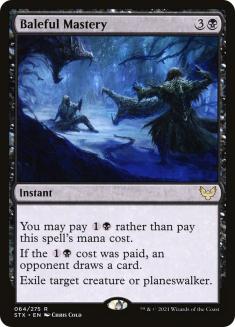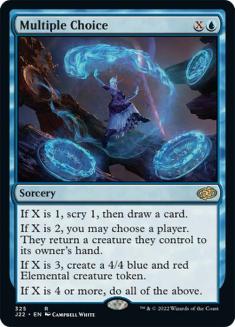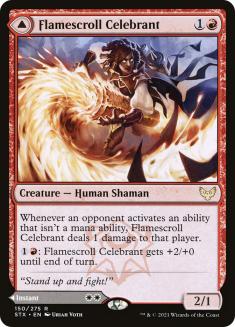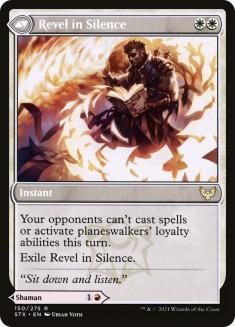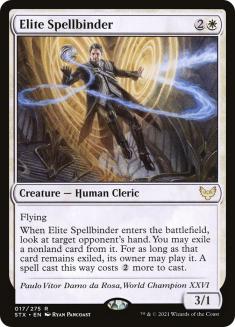Class is now in session at Strixhaven: School of Mages! Man. I’ve been doing too many ad reads lately…
At any rate, we have the full Strixhaven card list, and it’s time to really start working on updating our Cubes with the new cards. At this time I’ve had my first dose of the COVID-19 vaccine and I’m overflowing with excitement to start having Cube nights again. Hopefully you’re all in a similar situation or will find yourself in one soon.
I was a bit cold on Kaldheim in terms of Cube considerations, and my list of cards that I was excited for didn’t reach much beyond my Top 10 list. Strixhaven offers significantly more considerations, and Justin Parnell and I recorded over five total hours of discussion of all the options for last week’s and this week’s episodes of The 540. If I understand the schedule here correctly, you’ll be getting the second installment of that tomorrow. The wizard school aesthetic resonates strongly with a lot of players, and I believe that it’s supported very well mechanically. Let’s take a look at the set’s major mechanical offerings and then break down the ten cards that I expect to be most impactful across all Cubes.
Learn
Learn as a mechanic and Lesson as a subtype were fun things to keep on eye on during preview season, though now that we have the full card list the selection falls a bit flat for me. The mechanic and the cards printed with it leave something to be desired when compared to historically powerful cards, though they’re charming and I’m sure that a number of lower-powered Cubes will incorporated learn in some capacity.
I mentioned on The 540 that Strixhaven immediately strikes me as the sort of set that I expect people to build Cubes wholly dedicated to. They did a great job with the world-building and the set looks like it lends itself to a fun Booster Draft environment. I don’t personally have big plans for learn, but I’m sure that there are players who do and ultimately the best thing about Magic is that there are many ways to play.
Magecraft
I’m mostly past reading “metalcraft” every time I see this keyword, and I’m mostly over just wishing it was prowess, but there have been some growing pains. Now that I’ve had some time to get over the barriers presented by being old and easily confused, I can say with some clarity that magecraft and the execution thereof in Strixhaven are awesome. Implementing one mechanic across all five colors contributes to the set’s cohesion and also offers Cube designers an easy way to establish flexible and dynamic Draft lanes. It’s really cool when every color offers different incentives for casting the various cantrips, removal, and other instants and sorceries present in a play environment.
The majority of the cards that I will be adding to my personal Cubes feature the keyword magecraft, though you’ll see comparatively few on my Top 10 list. Ultimately the mechanic does require some attention in your design and there’s no shortage of prowess creatures that already exist and underperform in the absence of robust and specific “spells matters” support. Consider these and similar cards my honorable mentions for the set:
I intend to come back to these cards for some future content, because I think they’re reasonably powerful and fun to play with. For now, let’s get down to my broad strokes Strixhaven Cube Top 10 list.
10. Rip Apart
Based off the reactions to this card on Twitter, I’d get ripped apart if I didn’t feature it on my list. All the same, I will not allow public pressure to shame me off providing level-headed analysis on how good the card actually is.
This comparison obviously isn’t fair because Aurelia’s Fury is actually bad bad, but the point is that Rip Apart is significantly weaker than the hype I’ve seen expressed would suggest. This is a fine card and one we discussed at length on the podcast. Ultimately, red and white Cube decks bias aggressively and this card is just not there for what aggressive decks want. There are one-mana options to destroy Signets or creatures that offer that sort of thing as an enters-the-battlefield ability, and there are plenty of more efficient and/or instant-speed answers to creatures and planeswalkers. Then there’s also the “Boros problem” where Boros decks tend to perform worse than either mono-red or mono-white anyway, and all of this is to say that you have to offer these decks more to go gold.
I do think that Rip Apart will perform admirably in Jeskai control decks that are generally interested in a Disenchant anyway. It’s also clear that a lot of people have committed to adding this card to their Cubes, and I won’t be the least bit surprised to see it in any and all of the digital Cube offerings on Magic Online and Arena. I’m just saying that the card is closer to “good enough” than “very good.”
9. Sedgemoor Witch
Most of the aggressive magecraft creatures didn’t crack my Top 10, but Sedgemoor Witch is pushed just a bit harder than the rest of the lot. It has three abilities that all lend themselves very well to aggressive strategies, and the sum of its parts leaves it needing less support than something like Clever Lumimancer. Whether you’re playing a sacrifice deck or something closer to a prowess strategy, you’re getting your mana’s worth here.
My one reservation about Sedgemoor Witch is that a two-mana creature with a little less text would actually be significantly better. If you’ve Cubed a lot you know that it’s easier to fit a Young Pyromancer in a deck than a Monastery Mentor. That comparison is also somewhat illumining because Monastery Mentor is more of a haymaker than Sedgemoor Witch when it does its thing, but even still the card is easily good enough to show up in even the most powerful Cubes as-is.
8. Prismari Command
Once again, I’m on the other side of the hype on this one. This card has been hailed as better than Electrolyze and Kolaghan’s Command and I believe it to be worse than both in the average case. All the same, those cards are tried and true Cube staples, and it says something to be mentioned in the same conversation as them. I see the initial reaction to Prismari Command as an overcorrection to people misevaluating Kolaghan’s Command initially, but there’s plenty to work with here all the same.
As long as it’s reasonable to spend three mana killing a two-toughness creature in your Cube and your Cube has some nice artifacts to destroy, you’ll be happy playing with Prismari Command. I actually think that this is one of those cards that plays much better in Vintage Cube than lower-power-level Cubes for this reason, as an environment like Arena Cube just involves more three-plus-toughness creatures and fewer artifacts.
Ultimately, the games where you destroy an artifact and a creature or planeswalker will make this card worth the slot. It’s going to perform worse than that on average, but the average case is fine and the best case is exceptional.
7. Vanishing Verse
Am I more impressed by the instant-speed removal spell in a color pair that’s generally more interested in that sort of thing than the sorcery spell in the color pair that almost always skews aggressive? Yes.
Vanishing Verse won’t always be the perfect tool for every game, but Cubes generally have more mono-colored cards than gold or artifact cards. There are just a ton of permanents that Vanishing Verse will trade up on mana against when it exiles them, and I’m honestly a bit surprised that this one is an instant. I think it’s very plainly a powerful Cube card.
It’s worth mentioning here that Fracture didn’t end up making my Top 10 list, but I see it as very Cube-able and it has a lot in common with these other removal spells. There’s only so much room in most Cubes for removal that can’t target creatures, and for that reason I don’t love committing a gold slot to Fracture. I’d maindeck it in some of my Vintage Cube decks, but I’d be less excited about it as it compares to Disenchant than Rip Apart and Vanishing Verse.
6. Professor Onyx
The mana cost on this one is a little tough to get past, but all the same I’m bullish on the card. I’m a holdout that still plays Yawgmoth’s Bargain in my Vintage Cube decks, and while Yawgmoth’s Bargain didn’t even make the cut in MenguCube, I do see Professor Onyx as a Storm support card that will often perform better.
Professor Onyx has a loyalty-gaining ability that both offers card selection and stocks your graveyard, which is perfect for setting up Yawgmoth’s Will, and the additional cards towards giving your Cabal Ritual threshold will matter in some games as well. The main draw to the card is that the static ability is basically offering you access to more Tendrils of Agony, and if these two things were all the card did, there would be an argument to play it in the average Storm draft. Tack on the Edict ability and there’s even more to like!
Storm is pretty narrow though, and the truly exceptional thing about Professor Onyx is that the card can function as a control win condition without building to its ultimate. If your opponent can’t get Professor Onyx off the battlefield, you’ll be able to cantrip and kill spell your way to victory. This is the sort of card that you can just toss in basically anywhere and it will perform well enough, and that will excel given specific support.
5. Expressive Iteration
If you’re interested in really involved analysis on this card, check out Todd Anderson’s article on it. There’s a lot of competition when it comes to Cube-worthy Izzet cards, and even still I think this one is very impressive. It’s very common for me to play Chart a Course in Vintage Cube even when I don’t care about the discard outlet, and Expressive Iteration is going to be worth two cards at least as often in an environment like that.
Any environment with a magecraft / prowess theme is going to love this one, but once again it has plenty of broad appeal beyond that. Divination wouldn’t be an exciting card to draft in most Cubes, but it would be pretty reasonable to play all the same. The most common play pattern for Expressive Iteration is going to be finding a land drop and another card to save for later, and when that works this card is just a two-mana Divination. In all likelihood it will be correct to try to save this card for a turn when you can convert it into two spells, but even the fail case is solid.
Expressive Iteration gets worse the higher the mana curve of your Cube is by its nature, so I expect that I’d play it in more Vintage Cube decks than Arena Cube decks, but I see it as worth considering for any power level of Cube.
4. Baleful Mastery
I’m going to show some bias here, because this card is perfect for Twoberts. That Cube is all about attrition and positioning on the battlefield, and a four-mana answer to a creature or planeswalker that can be cast at a discount is going to be worth giving up a card pretty often, and when all things are equal it will trade even or up on mana against a lot of great cards when cast for four.
Baleful Mastery is less perfect for most Cubes, but it does compare favorably to a number of similar cards. The two life off Vraska’s Contempt has rarely mattered in my Cube games, and I think this is any easy upgrade in terms of splashability alone for most Cubes that feature a Vraska’s Contempt. I also believe that it will perform better than Hero’s Downfall in a number of Vintage Cube games with it comes to competing with an early Reanimate or Black Lotus. Sometimes mana efficiency is just everything.
Even if you’re cold on the idea of casting the card for two, it’s easy to imagine being light on mana and wanting to use the alternate cost on Baleful Mastery some of the time. I wouldn’t necessarily endorse cutting a two-mana removal spell for it, but I’d easily Cube it over Eat to Extinction and similar cards.
3. Multiple Choice
This card might not read the most exciting seeing as it’s four fail cases and then a fine five-mana card, but the five-mana mode on the spell is quite strong and there’s enough going on with the cheaper modes for me to strongly endorse this card.
Two mana for a sorcery-speed Opt sucks. I wouldn’t draft it, but I’d cast it if I was worried about missing land drops. A three-mana bounce spell that doesn’t always get what you want is generally very bad, but it’ll buy you time against something like Reanimator. A four-mana 4/4 is whatever, but it blocks. When you put it all together though, a cantripping 4/4 that can either bounce an opposing creature or rebuy one of your own is very solid.
This card might not be quite there for Vintage Cube, but I’d draft it over Cosima, God of the Voyage and there’s a lot to like here for lower-powered Cubes. This is another slam dunk for Twoberts.
2. Flamescroll Celebrant // Revel in Silence
Burning-Tree Shaman hasn’t been good for years. There are tons of playable two-mana red creatures. Nobody Cubes with Silence. But you know what — you take enough stuff that isn’t quite there and staple it together, you’re bound to land on something strong.
Successfully drafting aggressive decks in Cube comes down to having a plan for longer games and having an efficient mana curve. Flamescroll Celebrant gives you some of both. It’s not as good as something like Robber of the Rich or Young Pyromancer on Turn 2, but more than anything you want a high volume of options to make sure you have a play on Turn 2. Even if it’s not the best option there, it does offer a unique ability to punish opposing players and conveniently it demands an answer from your opponent before they can pull off a Splinter Twin combo.
Let’s say that you have better early plays and you don’t expect to lose to a combo. That’s where Revel in Silence comes in. If your early creatures are getting the job done, you just hang back and cast a Revel in Silence on your opponent’s upkeep a turn or so before you plan on attacking for lethal to really limit their ability to do anything about it.
This card does a lot of small things, and added together I see plenty to like.
1. Elite Spellbinder
That leaves us with the card made in the World Champion’s likeness. You can read all about the card from the man himself, and I have nothing but good things to say about the design. It’s powerful, it’s engaging, and it has avenues for common synergies. I love everything about Elite Spellbinder.
On rate, a three-mana 3/1 flyer doesn’t need much help to get my attention. Tack on a solid enters-the-battlefield ability and two relevant creature types and you’ve got yourself a stew going!
Blink effects like Ephemerate are pretty popular in Cube, and I personally have a Cube with a Human tribal theme and have been working on a Party Cube as well. Elite Spellbinder is just a good enough card to play without exploiting any of these synergies, so the fact that there are themes that support it is just gravy.
Once again, the only bad thing I have to say about Elite Spellbinder is that three is a very crowded spot on the mana curve, but it’s pretty plainly worth making room for. I would expect it to make the cut in all of the major digital Cube offerings and I’d play it in almost any white deck.
Strixhaven offers quite a lot of classically powerful cards to Cube with, and beyond that there’s plenty in the way of exciting niche cards as well. This is a major improvement over Kaldheim, and is in line with the success that I see Zendikar Rising as. If we keep getting sets of this nature, then this truly is the Golden Age of Cube Draft.


